I Scammed Influencer Caroline Calloway at Her Event, The Scam
Credit to Author: Anna Iovine| Date: Tue, 06 Aug 2019 20:13:42 +0000
“Bring your favorite pen and a piece of writing you’d like to work on. It can be printed out or you can just be saved on your phone [sic].
I can’t wait to scam you.”
This was the Eventbrite ticket description for Instagram influencer Caroline Calloway‘s latest event, The Scam, a five-hour “creativity workshop” held in a Manhattan loft on a hot Saturday in August.
VICE and other outlets have written about Calloway several times over the past few years; she’s tended to respond in ways that serve her interests. She posts long lamentations and screenshots on Instagram; she calls out journalists by name; she writes long-winded captions about events that occurred years ago, including articles covering these events. Whether she even needs to do this sort of thing is questionable, given the relatively newsworthy nature of her antics—this is the same woman, after all, who broke a $500,000 book deal and got herself in over $100,000 in debt; canceled her “tour” of $165 creativity workshops at the beginning of this year; sold merchandise such as $48 caps that say “Self Obsessed Mess” (hearkening back to a VICE headline); and sold boob paintings for $80—but griping about coverage in ways that, at the very least, come off as calculated to draw more coverage would seem to be within the purview of an influencer’s job.
Even at a long shot, Calloway is no Billy McFarland. At best, she’s a half-assed grifter, seemingly more concerned with plastering “Self-Obsessed Mess” on a cap for profit than with looking inward as to why doing so is her response to criticism. But that doesn’t mean there’s no potential harm in what she is doing. As journalist Kayleigh Donaldson, who authored a viral Twitter thread about Calloway’s failed tour, wrote in January, “Plenty of people have been quick to tell me they don’t think she’s a real scammer, just an incompetent dolt who got in way over her head. But I’m not sure that option is much better … She harnessed that fan devotion for profit based on skills she did not possess and services she could not provide, and anyone who dissented from that loyalty was ‘inauthentic.'”
Calloway is far from alone in this. She’s just one of many people who make their living as an “influencer,” profiting by making their lives look as enviable as possible on social media. She boasts almost 800,000 followers at the time of this publication (down from the 850,000 figure cited in a 2018 Man Repeller interview), and in 2019 that number seems to counts for a great deal more than knowing, or having insight into, anything in particular.
She may not be selling flat tummy tea, as the Kardashians do, but she is selling an illusion—that one can be good at their craft, and live well off it, by posting on Instagram all day, having a camera roll with hundreds of selfies, and doing not much actual work at all. Like McFarland, she is banking on people’s desire to have a lavish lifestyle and have millions pay attention to it. That’s the scam. The difference between her and McFarland is that she hasn’t managed to trick big investors (other than her former book publisher) into biting. That doesn’t mean it hasn’t had an effect.
Calloway’s latest “Scam”
When Calloway announced her latest event on Instagram, I was immediately intrigued, especially because, in an apparent attempt to repurpose a term journalists and many people on the internet have used in reference to her botched tour, Calloway named the event “The Scam.” The cost remained $165, the same as the creativity workshops she canceled. I was going to the workshop, eager to get scammed myself.
It didn’t quite turn out that way.
The day after I purchased a ticket, Eventbrite alerted me that The Scam could, in fact, be a scam. “We are reaching out to you because it has come to our attention that the tickets you purchased for ‘The Scam’ were offered by an unauthorized third party and cannot be guaranteed at the door,” the email read. The Eventbrite link went down for several days.
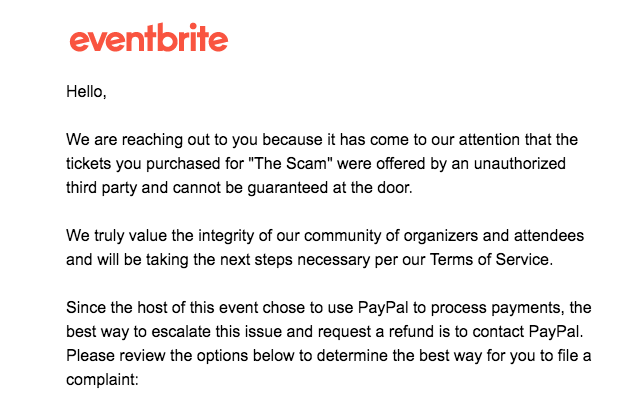
I emailed Calloway’s manager, Adam Krasner, who told me that the event had been falsely reported as fraud and that the Eventbrite link would be up again soon; an Eventbrite spokesperson confirmed this to me.
Hours after Krasner said this, though, he emailed me again to declare that all his correspondence was off the record and that Calloway “ha[d] chosen not to invite press” to The Scam. (Since I did not agree to treat his correspondence as off the record, it is not, despite his proclamations.) I was, he said, to be refunded by PayPal. Soon enough, in classic fashion, Calloway wrote about me on her Instagram:
“I’m writing about VICE today because I just found out that one of their reporters bought a ticket to The Scam so they could cover it,” she wrote. “My manager is refunding this ticket as I type.”
Calloway then emphasized that the press was barred from attending. “This event is not open to reporters. It will be only us—the true fans, true friends. I don’t trust journalists anymore for obvious reasons,” she wrote. “The only ‘press’ I’m even considering these days are PODCASTS because at least it’s harder to twist my words with an audio recording because you can’t chop off my idea mid-sentence.”
The fact that Calloway banned press and me specifically just further fueled my desire to go to The Scam. It also made me curious about what else she could be hiding.
Calloway’s alleged legal troubles
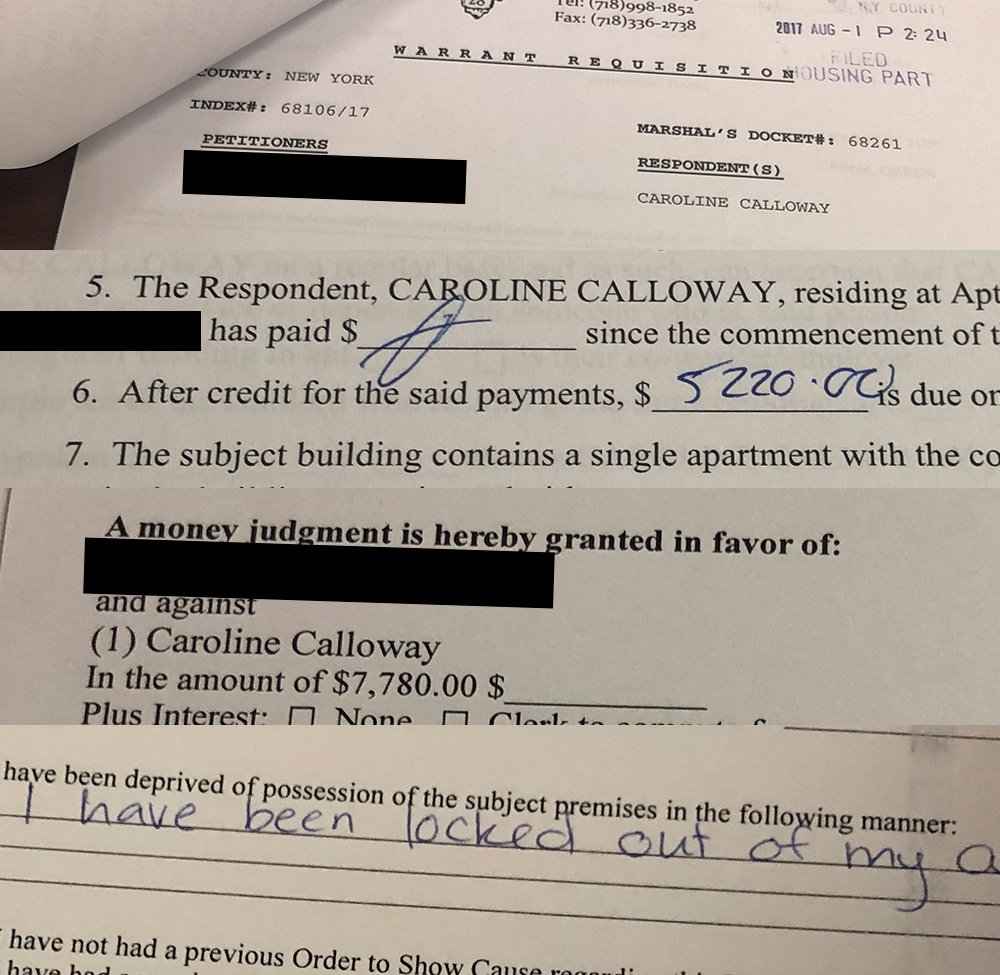
A quick background check on Calloway turned up four civil court cases, all pertaining to issues with the landlord who owns her much-Instagrammed New York apartment. Two were from 2017, one was from 2018, and one was from 2019; all were non-payment proceedings.
“Non-payment proceedings are brought when a tenant does not pay their rent,” said Samuel Golberg, a New York City tenant attorney who reviewed the court documents for VICE.
In the two cases from 2017, no money judgement went through. This is because the initial court documents were served by conspicuous place service.
“Conspicuous place service means that the process server was unable to personally serve the document on the respondent,” Goldberg explained. We can assume, however, that she did eventually pay her rent, because future cases involve the same landlord and the same apartment.
The 2018 case is different from the previous two. In it, a judgment of possession was granted to the petitioner—the landlord—and a money judgment of $7,780 was granted against the respondent, Calloway. (In this case, the process servers were able to personally serve her, according to the affidavit.) “In this non-payment case, the reason why it was $7,780 is because the landlord alleged that rent wasn’t paid for February, March, and April,” Goldberg said.
Since there was a fourth case, we can assume again that Calloway did eventually make payments, as she did not leave the apartment and was again in a position to be asked to pay her rent. On June 17 of this year, a judgment of possession was granted. “The marshall,” Goldberg said, “could have gone to evict. [We can see] the marshall in this situation went through with the eviction because they respondent did an order to show cause to restore possession, which was heard on July 23.”
Calloway wrote in her affidavit of support that she was locked out of her apartment and ready to render the full payment in court. The documents show that she paid over $11,000, including legal and marshall fees. She was restored possession, and case was then discontinued.
The landlord’s lawyer did not respond to multiple requests for comment. After being asked for comment, Calloway posted texts from her management to her Instagram page. “I’m embarrassed that I’ve struggled to pay my rent on time,” she wrote, “but it’s the truth.”
According to the documents, Calloway filed an order to show cause to restore possession of her apartment on July 23. She posted about me on Instagram on July 24. Priorities.
The Scam
To circumvent the fact that the organizers of Calloway’s event—from which the press was barred—knew my name and could potentially Google my editors should they attempt to buy tickets, my editor’s husband bought one under his name. What I failed to gather until I stepped into the loft in Manhattan’s Kips Bay and was asked my name by one of Calloway’s friends was that would now be someone named “Jeff” for the day. “Call me Jay,” I told everyone. In a setting where people had posh Upper East Side names, attendees and staff accepted it.
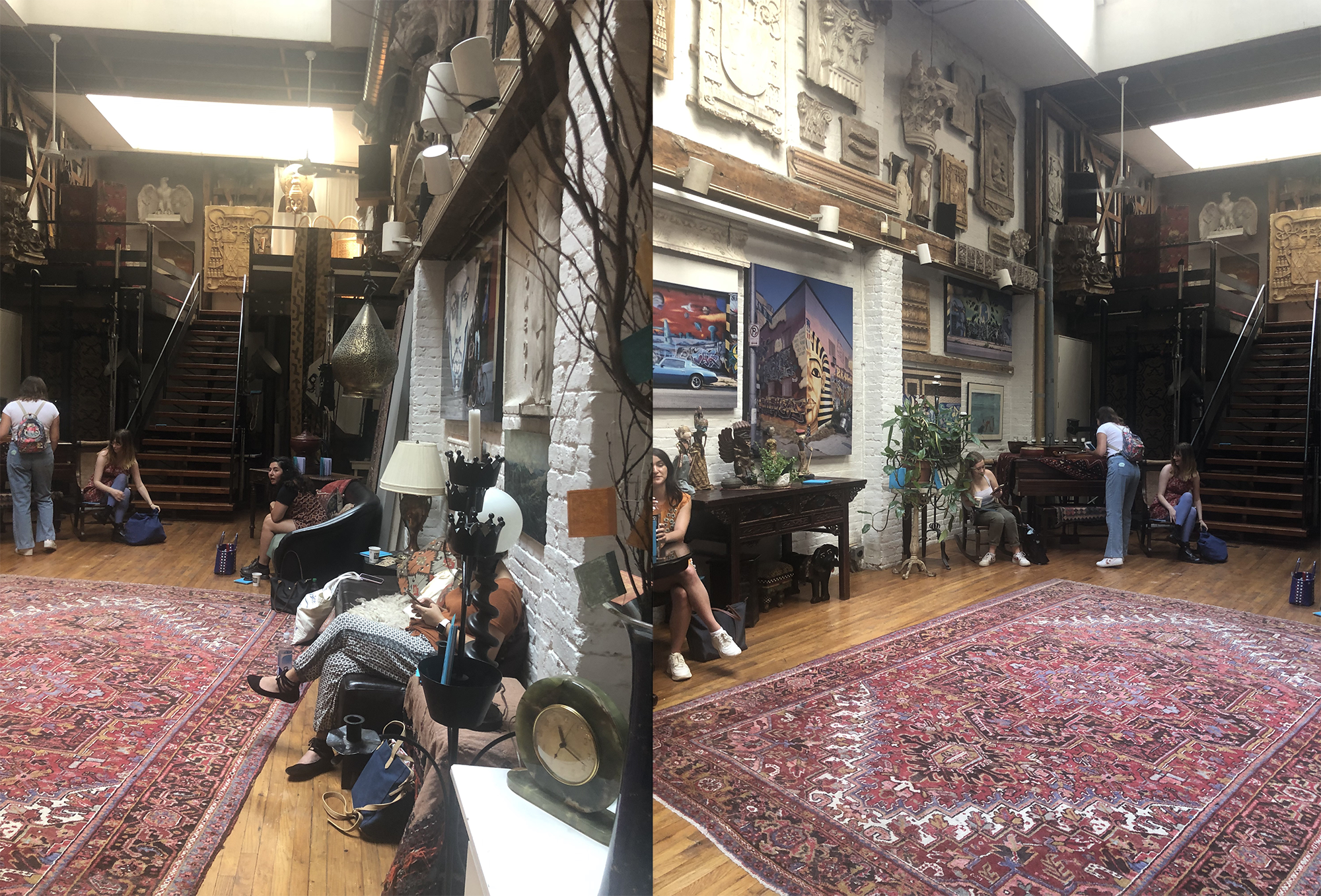
The loft was beautiful, a sprawling space with art of different styles and eras covering the walls. There was hot coffee, oat milk, and stevia available for attendees. We were instructed to look for our own notebooks, as they were scattered on different surfaces of the loft for us to find. Tucked in each notebook was an envelope with the attendee’s name on it, and inside were stickers with which to decorate the notebook. Kale caesar salad, pita chips, and hummus were offered later for lunch.
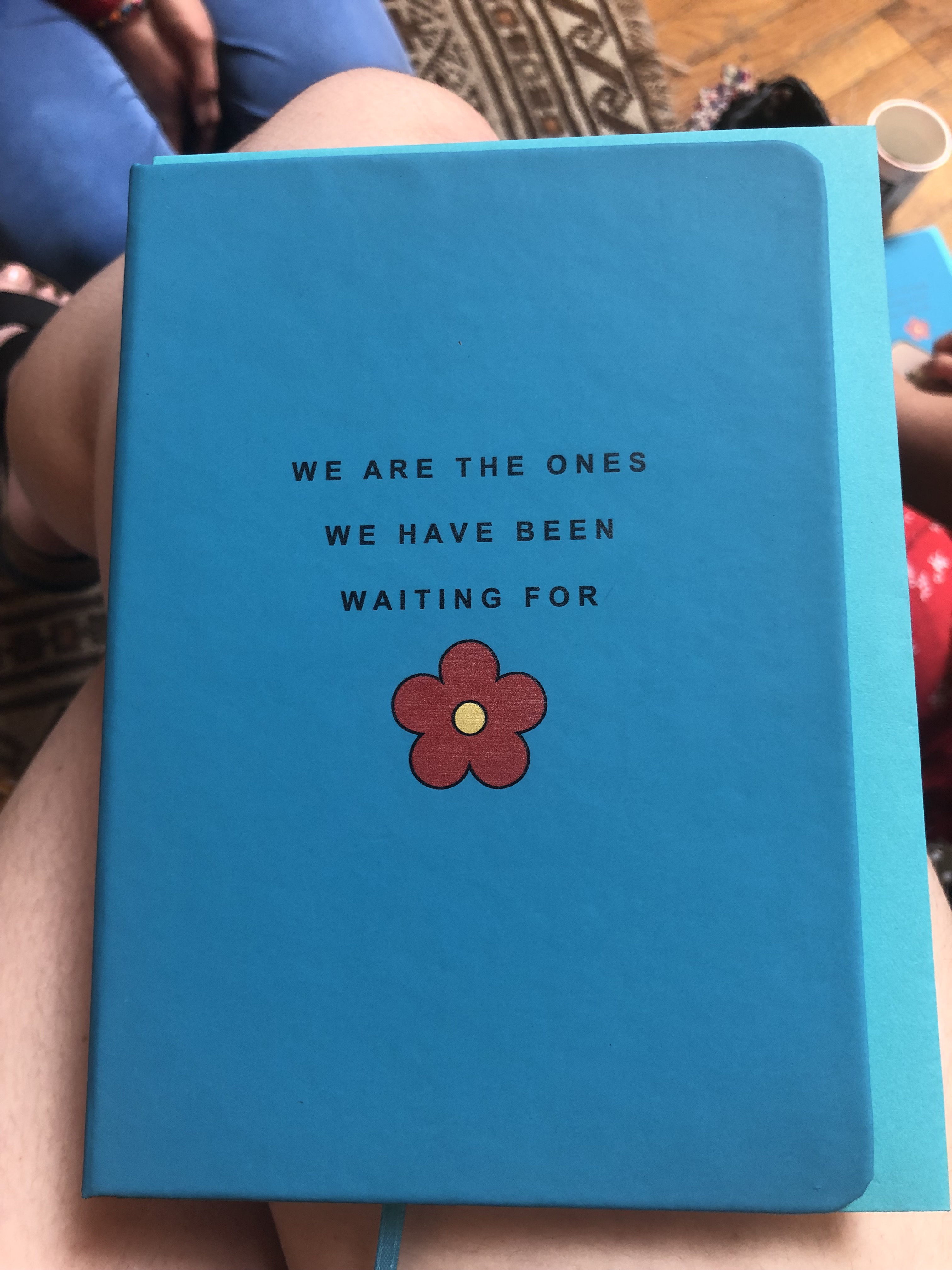
The event began at 11 a.m., but Calloway herself did not arrive until after noon. In the interim, I spoke with other attendees. Some were college students, others were in their late 20s. Some lived in Brooklyn, as I do; others took bus rides at 5:00 a.m. from out of state to get there. They talked about their Urban Outfitters dresses and their plans for the Saturday evening ahead. I am a white woman in my 20s, just like Calloway herself, and just like most of my fellow attendees. I fit right in.
No one I spoke to knew what to expect. “This is like a meet-and-greet,” an attendee told me. “A meet-and-greet with an influencer.”
I asked one staff member, a friend of Calloway’s, if this was so; she said this was mostly a “networking event.”
After Calloway arrived and introduced herself to the group, she asked her friends to go to a liquor store and buy white wine for everyone. (At this point, it was around 1 in the afternoon.) Then, she split up the 30 or so people in attendance into groups of five to share the art or writing we’d been instructed to bring along with us. I was in a group with other young women, some still in college and others just graduated—all, as far as I could tell, legitimate Caroline Calloway fans. “I just don’t understand why people are so hard on her,” one of them sighed.
Then, in a twist of fate, Calloway decided to join my group. Each of us went around and discussed the work we had brought, wine in one hand and phone in the other. “Jay” read a poem that I, Anna Iovine, wrote last year—it was about body image issues that cropped up on a plane flight—off my Notes app.
She looked into my—Jay’s?—eyes and told me how good the poem was. I noticed her earring, a dangling charm that said “ANXIETY,” spelled out in letter beads. When it was her turn to share, Calloway said that she was working on how she would write about this event for her Instagram caption that evening. She asked us all to go around and say what we enjoyed about the day so far.
Soon after, Calloway instructed that the small groups should pick one person to present to the entire workshop. No one could look at whomever was speaking; instead, they had to look at the various artwork around the event space. She had my group guess what number she was thinking in order to pick who should present. I had guessed correctly, and walked up the stairs of the loft to read my—my?—poem from a balcony.
Everyone applauded.
What stuck out to me was how talented the attendees were. People brought artwork, embroidery, and very vulnerable pieces of writing. My own piece of writing was personal to me; I had never read it out loud before. The contrast between the work the attendees brought along and Calloway’s—she seemed to just be crowdsourcing material for a future Instagram caption about the event—was staggering.
In the final hour of the event, Calloway answered several questions about her love life and the “creative process.” She explained that she had not written anything for the past three years—she did not clarify whether Instagram captions counted—and was now getting back into it. The last portion was a photo opp: Attendees lined up to take individual photos with Calloway and flowers before her friends/staff, who had disposable cameras and a Polaroid. An attendee’s comment about this event being a meet-and-greet popped into my mind. She was right.
It was my turn for a photo with Calloway. She looked into my eyes and said, “I have to tell you a secret.”
My heart sank—she knew. She knew all along. And now I was going to be thrown out.
Instead, Calloway told me that she had wanted me to read out loud to everyone all along, and tailored whatever “number was in her head” to whatever I said. She pinned an orchid in my hair, and we posed with plants and a yellow flower. All the while, her friends/staff kept snapping photos of us.
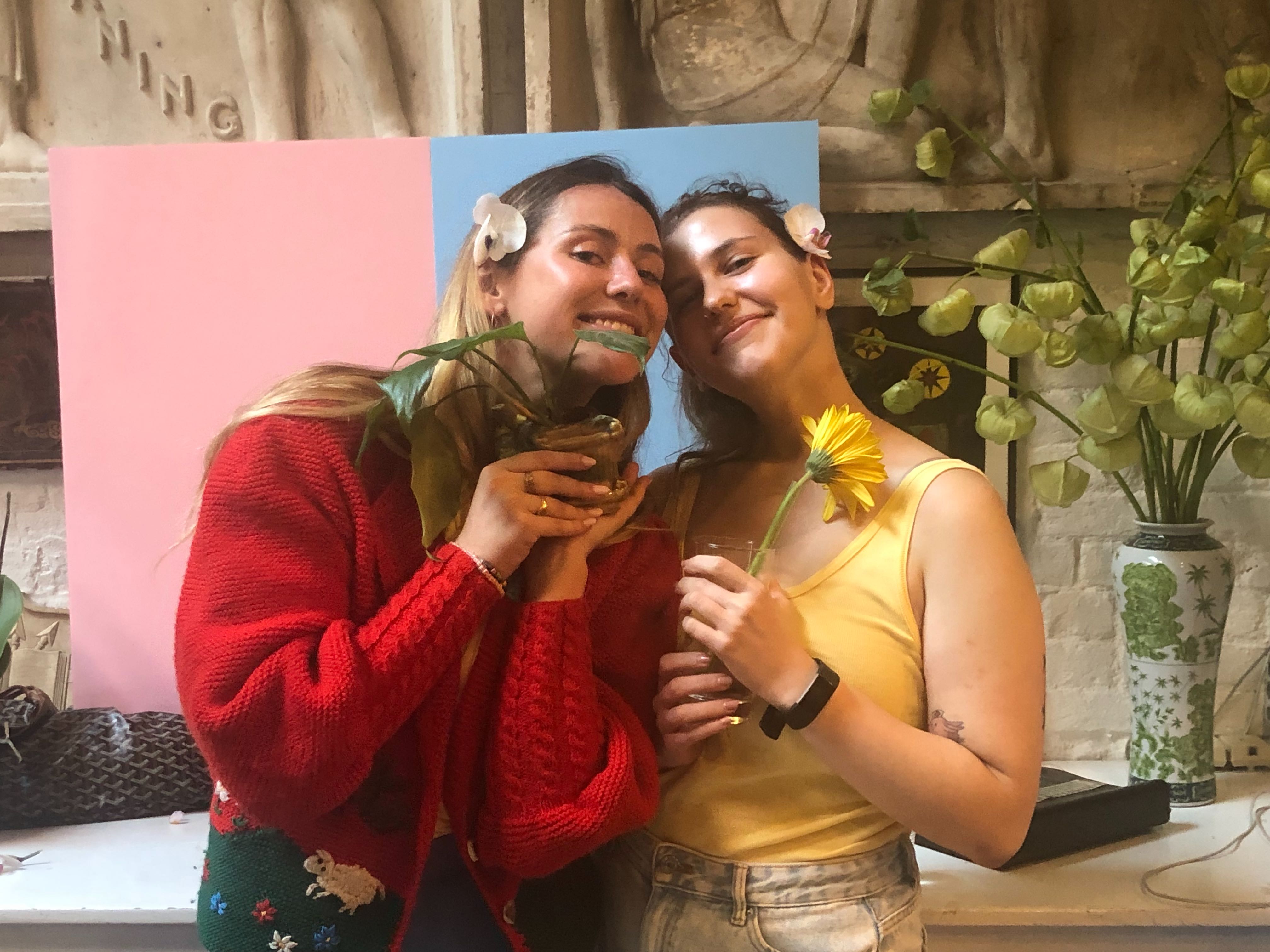
Calloway asked for my Instagram account. “I deleted mine,” I lied. “I’m sick of the toxicity.” She nodded, and said she understood. Then she shooed me away to pose for the line of cameras with the next attendee.
I swung the goody bag—complete with a face mask, small notebooks, a candle, and a matchbook with a fake crest for “Calloway House, Cambridge”—over my shoulder and exited the loft.
I didn’t feel good lying to Calloway or the attendees about who I was or my motives. I did sincerely present my art in a space without judgment, as did others. It was refreshing, but I got nothing out of the five hours besides that. While Calloway had granted “scholarships” to fans who DMed her on Instagram to tell her why they couldn’t afford The Scam, others paid over $170 including Eventbrite fees to be there. People took trains and gave up their Saturdays. Was it for a networking event and a notebook? A plate of kale caesar salad? Someone was scammed—who and how?
As I walked to the subway, I thought about whether the money Calloway earned from The Scam was going towards her rent this month. I thought about where the various attendees I spoke to lived: Westchester, New Jersey, Maryland, places very different from the West Village apartment Calloway resides in, the one with enough natural light for a thousand selfies and decor to rival the inside of an Anthropologie. It’s also the same apartment her landlord has filed multiple non-payment proceedings about. Calloway has not written a winding Instagram post about that aspect of her life, or how not meeting her obligations until the money to pay them mysteriously appears plays into The Scam (until prompted to by our questions). She has managed to write about me and to lie about several aspects about the event—claiming, for instance, that she carded everyone. (She did not, and I know that because I do not have an ID that says “Jeff.”)
What can you say about this? If you say Calloway is an extreme example of the facade that is influencer culture, it doesn’t land, because that’s built into what she’s selling. She sells out a single event months after she was set to do an extensive tour. She takes idyllic photos of the apartment her landlord has seemingly threatened to evict her from. She hosts creativity “workshops” when she could not deliver on her $500,000 book deal. She does not have a writing portfolio, only her Instagram account. If you say anything about this in coverage of the sort she publicly courts, she uses it as evidence she is a victim, and that the people who aspire to be like her—who are smart enough to be in on the ruse, and go for it anyway— are her real friends. What you can say is that she’s a real life example of “expectations versus reality,” just like the photos she posts, which look very different when zoomed out on than they do cropped, showing the messiness and fakery . The Scam is a scam, and its winking self-referentiality serves in the end to do nothing much more than to gloss over that it is, in fact, a scam, perpetuated by someone who, probably like a lot of the people who attended the event, has a hard time meeting their rent.
As Calloway pinned the orchid to my hair, I recalled the Instagram caption she wrote about me merely days prior. “This reporter can suck my big fat cock,” she said, “and she can quote me on that!”
Sign up for our newsletter to get the best of VICE delivered to your inbox daily.
Follow Anna Rose Iovine on Twitter.
This article originally appeared on VICE US.